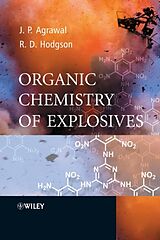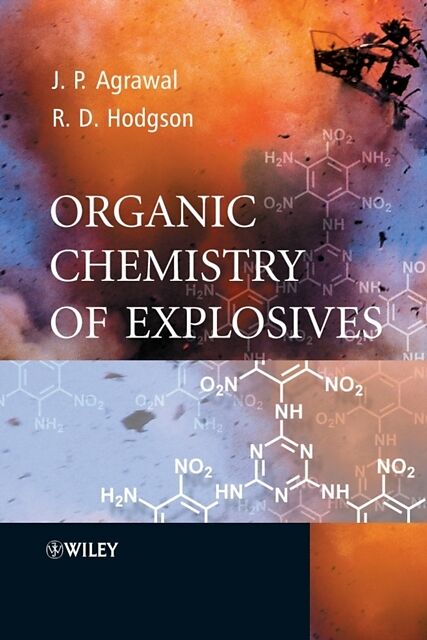Organic Chemistry of Explosives
Einband:
Fester Einband
EAN:
9780470029671
Untertitel:
Englisch
Genre:
Chemie
Autor:
Jai Prakash (University of Central Lancashire) Agrawal, Robert (University of Central Lancashire) Hodgson
Herausgeber:
John Wiley & Sons Inc
Auflage:
1. Auflage
Anzahl Seiten:
416
Erscheinungsdatum:
24.11.2006
ISBN:
978-0-470-02967-1
Informationen zum Autor Jai Prakash Agrawal is the former Director of Materials of the Indian Defence Research and Development Organization. He obtained his PhD in Chemistry from the Gorakhpur University, India, and did postdoctoral work at the University of Saint-Etienne, France, and at the Cavendish Laboratory of the University of Cambridge, UK. In recognition of his achievements Dr. Agrawal was appointed a Fellow of the Royal Society of Chemistry, London. The focus of his scientific and professional career is on research and development in the field of propellants, explosives and inhibitory materials. He has written a monograph on "Composite Materials" and is recipient of several honours including the prestigious DRDO Technology Award. Together with Robert Hodgson he has authored the book "Organic Chemistry of Explosives", John Wiley & Sons. Klappentext Explosives have attracted some unwanted publicity over the years for their misuse in the taking of life and the destruction of property. Although such concerns and views are not unfounded, there is a bigger picture. More explosives have been used in times of peace than in all of the wars and conflicts put together. How many of the great engineering achievements would have been possible if not for the intervention of explosives? Explosives are in fact no more than tools and remain as some of the most fascinating products of chemistry.Organic Chemistry of Explosives is the first text which brings together in one volume the essential methods and routes used for the synthesis of organic explosives. Topics are organised based on the fact that explosive properties are imparted into a compound by the presence of certain functional groups, and include:* the methods which can be used to introduce C-nitro, O-nitro, and N-nitro functionality into organic compounds* the synthesis of energetic compounds in the form of polynitropolycycloalkanes, caged and strained nitramines, and N-heterocycles* the synthesis of explosives containing functionality less widely encountered, including: organic azides, peroxides, diazophenols, and energetic compounds derived from guanidine and its derivatives* nitration with dinitrogen pentoxide and its likely significance for the future synthesis of energetic materials.This book also highlights important properties such as melting points, impact sensitivities and velocities of detonation etc. which are considered valuable from the end-use point of view.Organic Chemistry of Explosives is an essential reference source for chemists working in the field of energetic materials and all those with an interest in the chemistry of nitramines, nitro compounds, nitrate esters, and nitration in general. Zusammenfassung Explosives have attracted some unwanted publicity over the years for their misuse in the taking of life and the destruction of property. Although such concerns and views are not unfounded, there is a bigger picture. More explosives have been used in times of peace than in all of the wars and conflicts put together. How many of the great engineering achievements would have been possible if not for the intervention of explosives? Explosives are in fact no more than tools and remain as some of the most fascinating products of chemistry.Organic Chemistry of Explosives is the first text which brings together in one volume the essential methods and routes used for the synthesis of organic explosives. Topics are organised based on the fact that explosive properties are imparted into a compound by the presence of certain functional groups, and include:* the methods which can be used to introduce C-nitro, O-nitro, and N-nitro functionality into organic compounds* the synthesis of energetic compounds in the form of polynitropolycycloalkanes, caged and strained nitramines, and N-heterocycles* the synthesis of explosives containing functionality less widely encountered, including: organic azides, peroxides, diazophenol...
Autorentext
Jai Prakash Agrawal is the former Director of Materials of the Indian Defence Research and Development Organization. He obtained his PhD in Chemistry from the Gorakhpur University, India, and did postdoctoral work at the University of Saint-Etienne, France, and at the Cavendish Laboratory of the University of Cambridge, UK. In recognition of his achievements Dr. Agrawal was appointed a Fellow of the Royal Society of Chemistry, London. The focus of his scientific and professional career is on research and development in the field of propellants, explosives and inhibitory materials. He has written a monograph on "Composite Materials" and is recipient of several honours including the prestigious DRDO Technology Award. Together with Robert Hodgson he has authored the book "Organic Chemistry of Explosives", John Wiley & Sons.
Klappentext
Explosives have attracted some unwanted publicity over the years for their misuse in the taking of life and the destruction of property. Although such concerns and views are not unfounded, there is a bigger picture. More explosives have been used in times of peace than in all of the wars and conflicts put together. How many of the great engineering achievements would have been possible if not for the intervention of explosives? Explosives are in fact no more than tools and remain as some of the most fascinating products of chemistry. Organic Chemistry of Explosives is the first text which brings together in one volume the essential methods and routes used for the synthesis of organic explosives. Topics are organised based on the fact that explosive properties are imparted into a compound by the presence of certain functional groups, and include: * the methods which can be used to introduce C-nitro, O-nitro, and N-nitro functionality into organic compounds * the synthesis of energetic compounds in the form of polynitropolycycloalkanes, caged and strained nitramines, and N-heterocycles * the synthesis of explosives containing functionality less widely encountered, including: organic azides, peroxides, diazophenols, and energetic compounds derived from guanidine and its derivatives * nitration with dinitrogen pentoxide and its likely significance for the future synthesis of energetic materials. This book also highlights important properties such as melting points, impact sensitivities and velocities of detonation etc. which are considered valuable from the end-use point of view. Organic Chemistry of Explosives is an essential reference source for chemists working in the field of energetic materials and all those with an interest in the chemistry of nitramines, nitro compounds, nitrate esters, and nitration in general.
Inhalt
Foreword. Preface. Abbreviations. Acknowledgements. Background. 1 Synthetic Routes to Aliphatic C-Nitro Functionality. 1.1 Introduction. 1.2 Aliphatic C-nitro compounds as explosives. 1.3 Direct nitration of alkanes. 1.4 Addition of nitric acid, nitrogen oxides and related compounds to unsaturated bonds. 1.5 Halide displacement. 1.6 Oxidation and nitration of C-N bonds. 1.7 Kaplan-Shechter reaction. 1.8 Nitration of compounds containing acidic hydrogen. 1.9 Oxidative dimerization. 1.10 Addition and condensation reactions. 1.11 Derivatives of polynitroaliphatic alcohols. 1.12 Miscellaneous. 1.13 Chemical stability of polynitroaliphatic compounds. 2 Energetic Compounds 1: Polynitropolycycloalkanes. 2.1 Caged structures as energetic materials. 2.2 Cyclopropanes and spirocyclopropanes. 2.3 Cyclobutanes and their derivatives. 2.4 Cubanes. 2.5 Homocubanes. 2.6 Prismanes. 2.7 Adamantanes. 2.8 Polynitrobicycloalkanes. 3 Synthetic Routes to Nitrate Esters. 3.1 Nitrate esters as explosives. 3.2 Nitration of the parent alcohol. 3.3 Nucleophilic displacement with nitrate anion. 3.4 Nitrate esters from the ring-opening of strained oxygen heterocycles. 3.5 Nitrodesilylation. 3.6 Additions to alkenes. 3.7 Deamination. 3.8 Miscell…

Leider konnten wir für diesen Artikel keine Preise ermitteln ...
billigbuch.ch sucht jetzt für Sie die besten Angebote ...
Die aktuellen Verkaufspreise von 6 Onlineshops werden in Realtime abgefragt.
Sie können das gewünschte Produkt anschliessend direkt beim Anbieter Ihrer Wahl bestellen.
Loading...
Die aktuellen Verkaufspreise von 6 Onlineshops werden in Realtime abgefragt.
Sie können das gewünschte Produkt anschliessend direkt beim Anbieter Ihrer Wahl bestellen.
| # | Onlineshop | Preis CHF | Versand CHF | Total CHF | ||
|---|---|---|---|---|---|---|
| 1 | Seller | 0.00 | 0.00 | 0.00 |
